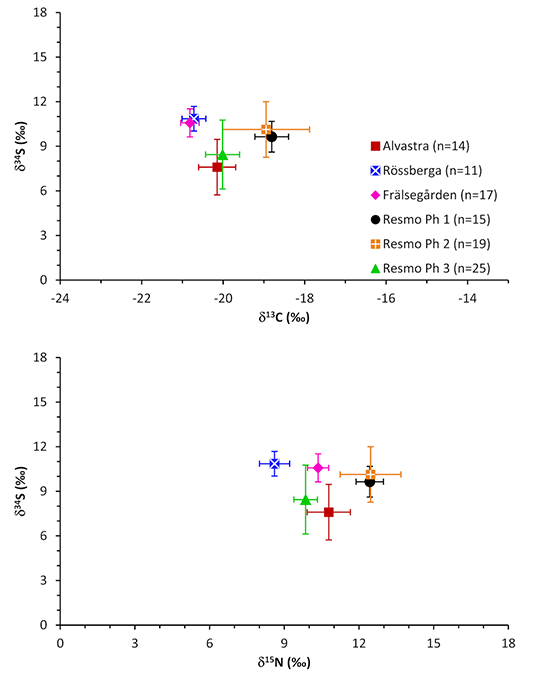
The fact that the Resmo passage grave was used during three separate phases, makes it necessary to consider the cultural context for each phase separately. Phase 1 in Resmo is linked to the erection of the megalithic tomb and its first use, and can on good grounds be associated with the Funnel Beaker Culture (TRB). Comparison with δ34S data from three other Swedish megalithic tombs may help put the Resmo data into a wider context. Data are available for the Rössberga and Frälsegården passage graves in Västergötland, both situated in the Falbygden area, and for the Alvastra dolmen in Östergötland - a monument which, together with the Resmo tombs and the Ansarve Hage dolmen on Gotland are isolated phenomena in the Swedish megalithic world, as they are the only ones located outside the core areas of Falbygden and the coasts of Bohuslän, Halland and Scania. The megalithic tombs at Resmo and Alvastra are consequently both unique features that can be expected to deviate from the Rössberga and Frälsegården tombs with regard to mobility patterns.

Only those human individuals from Rössberga, Frälsegården and Alvastra who have been directly radiocarbon dated, and coincide in date with Resmo Phase 1, have been included in the comparison (Figure 4). From Rössberga, the δ34S values of bone collagen from eleven individuals range from +9.8 to +12.4‰ (+10.9‰ ± 0.8‰), indicating an exclusively local origin, based on the limited variation and compatibility with δ34S of contemporaneous fauna from the tomb (Linderholm 2008). The fact that the Rössberga data derive solely from bone, could potentially result in less variation than the inclusion of both bone and dentine values. This, however, does not seem to be the case, as δ34S data from the other Falbygden megalithic tomb, Frälsegården, includes both dentine and bone values from eleven individuals (17 samples), with only a slightly larger range, from +9.1 to +12.3‰ (+10.6 ± 0.9‰). Bone and dentine collagen δ34S values from eight individuals (14 samples) from the Alvastra dolmen, by contrast, are much more dispersed, ranging from +4.4 to +10.6‰ (+7.6 ± 1.9‰), extending outside the faunal range, most likely including people from a much wider area than the vicinities of Alvastra (Fornander 2011). Although the geology at Alvastra is different from both Rössberga and Resmo, a comparison is nevertheless considered justified (for a detailed argument, see Fornander (Fornander 2011, 134f).
Somewhat surprisingly, the standard deviations of δ13C, δ15N and δ34S are largely similar for Rössberga and Resmo Phase 1, and there is much overlap between their δ34S values. It is also noteworthy that although Rössberga has a geology resembling that of Öland, and any sea spray effect can be ruled out, the δ34S mean for Rössberga is higher than for Resmo - the mere presence of δ34S values >10‰ in Resmo accordingly does not inherently imply a sea spray effect. The Alvastra dolmen stands out with its much higher standard deviations and much less overlap in δ34S values with the other two tombs. Thus, although Resmo is the site geographically most distant from the megalithic core area Falbygden, it was apparently not so different with regard to mobility.
In Figure 4, it is also evident that Phases 2 and 3 in Resmo are very different from the earlier phase, both in terms of variation and mean values. Especially Phase 3 seems to match the Alvastra dataset, which suggests that the level of mobility could be of a comparable magnitude.
Internet Archaeology is an open access journal based in the Department of Archaeology, University of York. Except where otherwise noted, content from this work may be used under the terms of the Creative Commons Attribution 3.0 (CC BY) Unported licence, which permits unrestricted use, distribution, and reproduction in any medium, provided that attribution to the author(s), the title of the work, the Internet Archaeology journal and the relevant URL/DOI are given.
Terms and Conditions | Legal Statements | Privacy Policy | Cookies Policy | Citing Internet Archaeology
Internet Archaeology content is preserved for the long term with the Archaeology Data Service. Help sustain and support open access publication by donating to our Open Access Archaeology Fund.
File last updated: Thu Nov 13 2014